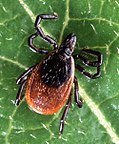Climate change and infectious diseases
Climate Change and Infectious Diseases
Climate change, characterized by global warming, extreme weather events, and rising sea levels, is a pressing environmental issue with far-reaching impacts on human health. Among these impacts, the alteration in patterns of infectious diseases is a significant concern. This article explores the relationship between climate change and the spread of infectious diseases, focusing on the mechanisms of influence, specific diseases affected, and strategies for mitigation and adaptation.
Mechanisms of Influence[edit]
Climate change affects infectious diseases through several direct and indirect pathways. These include:
- Temperature Increases: Warmer temperatures can expand the habitats of vectors such as mosquitoes (Aedes aegypti and Anopheles), which transmit diseases like dengue fever, Zika virus, malaria, and West Nile virus.
- Precipitation Patterns: Changes in rainfall can influence the breeding sites of disease vectors, affecting the incidence of water-borne diseases such as cholera and vector-borne diseases like malaria.
- Extreme Weather Events: Floods, hurricanes, and droughts can disrupt habitats and human settlements, leading to increased risks of diseases such as Leptospirosis and creating conditions conducive to outbreaks.
- Sea Level Rise: Rising sea levels can contaminate freshwater resources with saltwater, impacting the availability of clean water and increasing the risk of diseases like cholera.
Diseases Affected[edit]
Several infectious diseases are particularly sensitive to the effects of climate change:
- Malaria: Changes in temperature and precipitation patterns can alter the geographic range of mosquitoes, potentially exposing new populations to malaria.
- Dengue Fever: Warmer temperatures may increase the reproduction rates of Aedes mosquitoes, leading to higher transmission rates of dengue fever.
- Zika Virus: Similar to dengue, the spread of Zika virus is influenced by the expansion of mosquito habitats due to warmer climates.
- Cholera: Increased precipitation and flooding can contaminate water supplies with Vibrio cholerae bacteria, leading to cholera outbreaks.
- Lyme Disease: Warmer temperatures can affect the distribution of ticks that carry Borrelia burgdorferi, the bacteria responsible for Lyme disease, potentially increasing incidence in new areas.
Mitigation and Adaptation Strategies[edit]
Addressing the health impacts of climate change requires both mitigation of climate change itself and adaptation to its effects. Strategies include:
- Surveillance and Monitoring: Enhancing surveillance systems to detect and respond to outbreaks promptly.
- Vector Control: Implementing measures to control mosquito populations, such as eliminating standing water and using insecticides.
- Public Health Infrastructure: Strengthening public health infrastructure to manage and respond to disease outbreaks effectively.
- Community Education: Educating communities about the risks of infectious diseases and preventive measures.
- Research: Conducting research to understand the complex relationships between climate change and infectious diseases better.
Conclusion[edit]
The relationship between climate change and infectious diseases is complex and multifaceted. As the planet continues to warm, the impact on infectious diseases is likely to become more pronounced, necessitating concerted efforts in research, surveillance, and public health preparedness to mitigate these effects.
| Infectious disease control | ||||||||||
|---|---|---|---|---|---|---|---|---|---|---|
This infectious disease control related article is a stub.
|
-
Aedes aegypti mosquito
-
Creative Commons BY icon
-
Malaria deaths per million persons (WHO 2012)
-
World map of past and current malaria prevalence
-
Disease vector
-
Adult deer tick
-
Tick on human head
-
Anopheles stephensi mosquito
Ad. Transform your life with W8MD's Budget GLP-1 injections from $75


W8MD offers a medical weight loss program to lose weight in Philadelphia. Our physician-supervised medical weight loss provides:
- Weight loss injections in NYC (generic and brand names):
- Zepbound / Mounjaro, Wegovy / Ozempic, Saxenda
- Most insurances accepted or discounted self-pay rates. We will obtain insurance prior authorizations if needed.
- Generic GLP1 weight loss injections from $75 for the starting dose.
- Also offer prescription weight loss medications including Phentermine, Qsymia, Diethylpropion, Contrave etc.
NYC weight loss doctor appointmentsNYC weight loss doctor appointments
Start your NYC weight loss journey today at our NYC medical weight loss and Philadelphia medical weight loss clinics.
- Call 718-946-5500 to lose weight in NYC or for medical weight loss in Philadelphia 215-676-2334.
- Tags:NYC medical weight loss, Philadelphia lose weight Zepbound NYC, Budget GLP1 weight loss injections, Wegovy Philadelphia, Wegovy NYC, Philadelphia medical weight loss, Brookly weight loss and Wegovy NYC
|
WikiMD's Wellness Encyclopedia |
| Let Food Be Thy Medicine Medicine Thy Food - Hippocrates |
Medical Disclaimer: WikiMD is not a substitute for professional medical advice. The information on WikiMD is provided as an information resource only, may be incorrect, outdated or misleading, and is not to be used or relied on for any diagnostic or treatment purposes. Please consult your health care provider before making any healthcare decisions or for guidance about a specific medical condition. WikiMD expressly disclaims responsibility, and shall have no liability, for any damages, loss, injury, or liability whatsoever suffered as a result of your reliance on the information contained in this site. By visiting this site you agree to the foregoing terms and conditions, which may from time to time be changed or supplemented by WikiMD. If you do not agree to the foregoing terms and conditions, you should not enter or use this site. See full disclaimer.
Credits:Most images are courtesy of Wikimedia commons, and templates, categories Wikipedia, licensed under CC BY SA or similar.
Translate this page: - East Asian
中文,
日本,
한국어,
South Asian
हिन्दी,
தமிழ்,
తెలుగు,
Urdu,
ಕನ್ನಡ,
Southeast Asian
Indonesian,
Vietnamese,
Thai,
မြန်မာဘာသာ,
বাংলা
European
español,
Deutsch,
français,
Greek,
português do Brasil,
polski,
română,
русский,
Nederlands,
norsk,
svenska,
suomi,
Italian
Middle Eastern & African
عربى,
Turkish,
Persian,
Hebrew,
Afrikaans,
isiZulu,
Kiswahili,
Other
Bulgarian,
Hungarian,
Czech,
Swedish,
മലയാളം,
मराठी,
ਪੰਜਾਬੀ,
ગુજરાતી,
Portuguese,
Ukrainian







